AGU Fall Meeting 2018

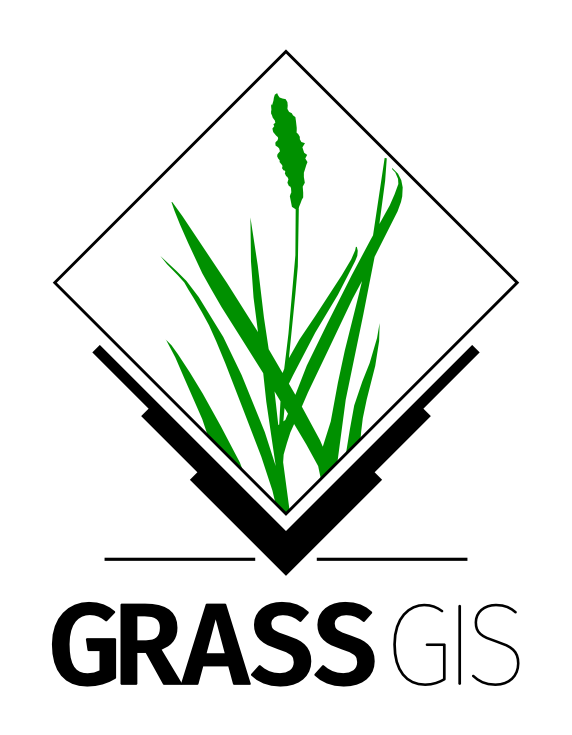
This page contains work related to GRASS GIS presented at Fall Meeting of American Geophysical Union in 2018, Washington, D.C., USA in December 10th-14th, 2018 (https://fallmeeting.agu.org/2018).
Posters and Presentations
Engaging stakeholders and decision-makers in geosimulations with Tangible Landscape
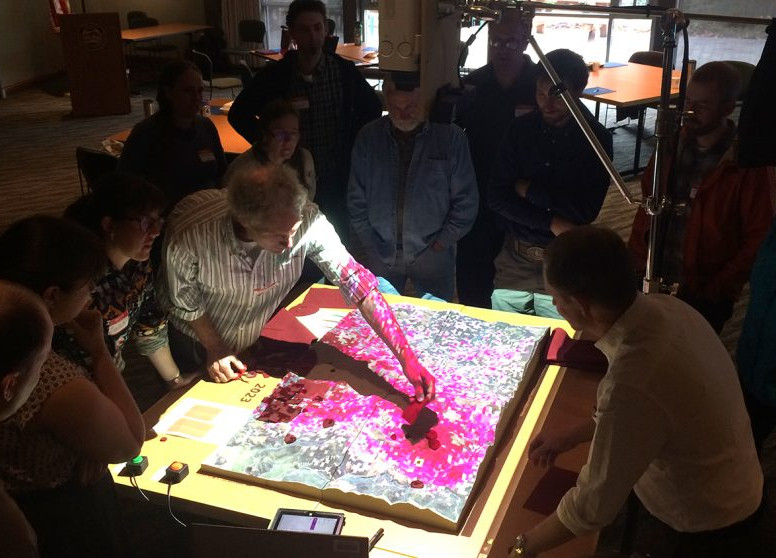
Info
- Authors: Anna Petrasova (1), Devon Gaydos (2), Vaclav Petras (3), Richard Cobb (4), Ross Kendall Meentemeyer (3) and Helena Mitasova (5), (1) North Carolina State University Raleigh, Raleigh, NC, United States, (2) North Carolina State University Raleigh, Center for Geospatial Analytics, Raleigh, United States, (3) North Carolina State University at Raleigh, Raleigh, NC, United States, (4) California Polytechnic State University San Luis Obispo, San Luis Obispo, United States, (5) North Carolina State Univ, Marine, Earth, and Atmos. Sciences, Raleigh, NC, United States
- Program entry: PA23G-1071: Engaging stakeholders and decision-makers in geosimulations with Tangible Landscape
- Presentation format: Poster
Abstract
- In the last few decades, geospatial simulations have become increasingly common in scientific research as a method to study complex spatial phenomena, such as urban growth or disease spread, and to effectively prevent or mitigate natural hazards, including flooding or wildfires. Although exploring simulated scenarios can help us predict future demands and risks associated with decisions and policies, geospatial simulations are often not designed for practical use in management. The black box nature and the lack of user-friendly interfaces of simulation tools make them inaccessible for decision makers and stakeholders, leading to a knowledge-practice gap. To address this challenge, we developed a decision support system on top of Tangible Landscape, an open source tangible geospatial modeling platform. By coupling a physical, scaled model of a landscape with powerful geospatial modeling platform, Tangible Landscape allows decision-makers to intuitively modify landscape and perform spatial interventions while instantly visualizing and quantifying the resulting effects. Tangible, spatio-temporal steering of the simulation enhances understanding of simulated processes, communicates uncertainties and builds trust between decision-makers and researchers. As a case study, we are leveraging this novel modeling platform to engage stakeholders involved in the management of a weather-driven plant disease aggressively spreading in California and Oregon. Our results suggest that Tangible Landscape is a promising platform for supporting decisions and building more robust, accurate scientific models.
GRASS GIS: A General-purpose Geospatial Research Tool


- Mitasova, H., Petras, V., Petrasova, A., Neteler, M. 2018: GRASS GIS: A General-purpose Geospatial Research Tool. https://agu.confex.com/agu/fm18/meetingapp.cgi/Paper/457963
- Presentation format: Lightning talk and poster
- Poster as PDF, slides as PDF
Abstract
GRASS GIS (grass.osgeo.org) is an open source software for geospatial analysis, remote sensing, general geoprocessing and visualization. It is a community-driven project with over 35 years of continuous software development based on scientific expertise from many geospatial fields. It is characterized by long-term releases, stable APIs, and emphasis on science. GRASS GIS distribution strives to provide single integrated environment for 2D and 3D raster analysis, image processing, vector data analysis, and spatio-temporal data processing. It supports large raster files (billions of cells), vector topology, coupling with databases, and 64 bit memory. New code based on recent research is typically contributed to GRASS GIS Addons repository. Mature, widely used code is then moved to the main code base to maximize integration and availability. Whether it is addons or the main code base, code is usually maintained by the community and preserved in long term even in cases when the original author no longer supports the code. To support the needs of scientists, the documentation includes not only links to the source code, its history, and its authors, but also links to research papers that describe the algorithms implemented in the modules.
Code is not only maintained but also extended and improved. For example, watershed and stream extraction using least cost path approach was implemented in 1989 and extended for massive datasets in 2011. Similarly, vector topology cleaning was introduced in 2002, updated over time and substantially improved in 2016. Another example is a solar energy module available since 1993 and parallelized in 2017. The current stable version of GRASS GIS 7.4 provides new features for geosciences such as temporal framework with temporal algebra for large time-series processing, fusion of elevation models from various sensors, 3D flows, landform detection, image segmentation, simplified batch processing, and integrated Python editor among others. GRASS GIS runs in various environments including Linux, Mac, Windows, Docker, Raspberry Pi, and on HPC clusters. The modules are written in Python, C, or C++. Besides command line interface, GRASS GIS provides a graphical user interface, a Python API, and a C API. Interfaces with other languages such as R and Ruby are supplied by collaborating communities.
Software Citation with Fine Granularity: The g.citation Module for GRASS GIS
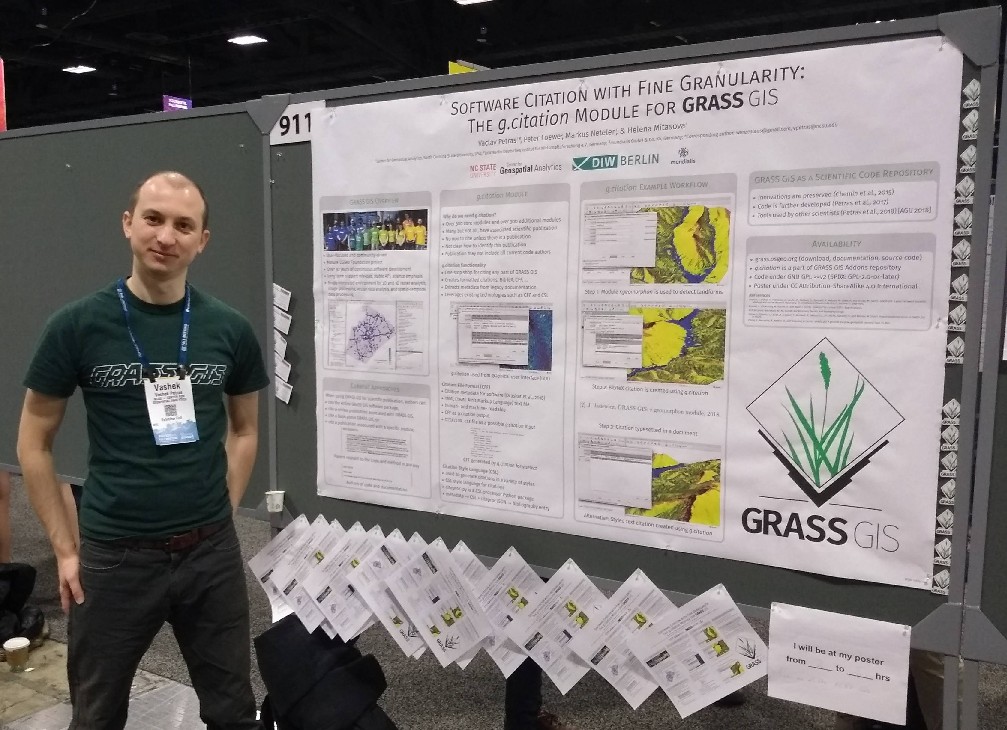
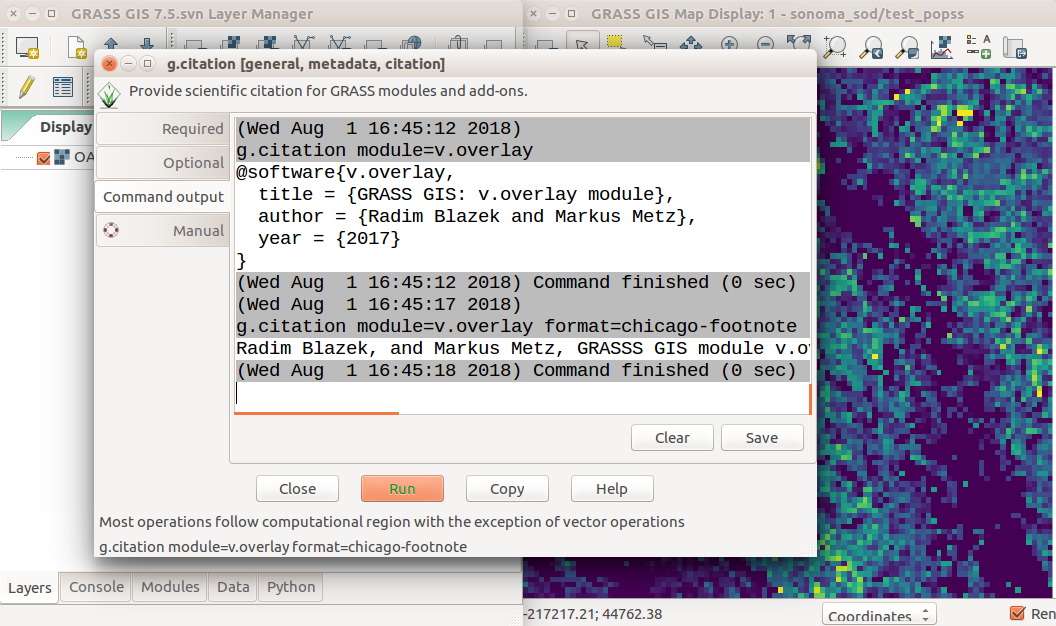
- Petras, V., Loewe, P., Neteler, M. 2018: Software Citation with Fine Granularity: The g.citation Module for GRASS GIS. https://agu.confex.com/agu/fm18/meetingapp.cgi/Paper/443741
- Presentation format: Poster
- PDF poster
Abstract
GRASS GIS (grass.osgeo.org) is a community-driven geospatial software project with a record of being used in scientific publications and research projects over three decades. Authors of scientific publications, when using and citing GRASS GIS, so far opted for citing either the entire software package, citing the most recent review publication associated with GRASS GIS, or citing a publication associated with a specific module.
GRASS GIS provides over 500 modules, each with a unique functionality and purpose, many with associated scientific publications. In addition to these core modules in the GRASS GIS distribution there is a growing number of additional add-on modules are being developed, often as part of research work. Until now, no automated, software-enabled citation mechanism to cite individual GRASS GIS modules, or functions in general was provided due to the lack of a reference citation standard for GRASS GIS modules defined within the GRASS GIS community.
We present a new GRASS GIS module g.citation with the aim to provide a convenient, concise, and standardized way of citing GRASS GIS and its individual modules. The current version of g.citation extracts the relevant information from a respective manual page of any given GRASS GIS module and turns this semi-structured record into a proper citation in a variety of styles and formats with the machine-readable Citation File Format (CFF) currently promising most efficiency and expressiveness in storing the information and Citation Style Language (CSL) used for formatting citations. The module is now in a prototype stage and it is available in the GRASS GIS Addons repository. Future directions include using standardized format for storing the citation information together with the code and incorporating persistent scientific identifiers such as DOI. We are now seeking collaborators and feedback from authors of geospatial algorithms who want to share their code and be cited at the same time.
Construction of Landscape Level QL2 LiDAR Data Sets for Species Habitat Assessment in Eastern North Carolina
- Newcomb, D., Petras, V. 2018: Construction of Landscape Level QL2 LiDAR Data Sets for Species Habitat Assessment in Eastern North Carolina. https://agu.confex.com/agu/fm18/meetingapp.cgi/Paper/433904
- Usage of GRASS GIS: All point cloud and surface analysis was performed in GRASS GIS.
Microtopography and Crop Vigor Changes Assessment Using Time Series of UAS Derived Data
- Jeziorska, J., Montgomery, K., Mitasova, H. 2018: Microtopography and Crop Vigor Changes Assessment Using Time Series of UAS Derived Data. https://agu.confex.com/agu/fm18/meetingapp.cgi/Paper/422064
Empirical Characterization of Fire Regimes Across the Globe
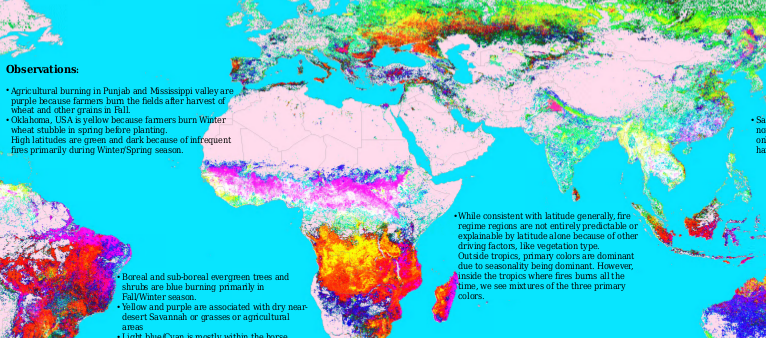
- Jitendra Kumar, William W. Hargrove, Steven P. Norman, Forrest M. Hoffman (2018). Empirical Characterization of Fire Regimes Across the Globe. https://agu.confex.com/agu/fm18/meetingapp.cgi/Paper/392732
- Poster: website, PDF
Abstract
Climate conditions, vegetation, fuel type and availability govern the occurence and behavior of fires. Understanding the seasonality, frequency, intensity, and severity of fires is critical for land managers to appropriately manage and plan the landscape and to understand the feedbacks to the Earth system. Fire Regimes are conceptually useful to land managers and are qualitatively understood, but few quantitative techniques exist for empirically delineating geographic regions whose wildfire spatial and temporal characteristics, re-visitation frequency, and intensities are similar.
We consider the extensive and consistent thermal “hotspot” data which are collected globally by the two MODIS sensors during their 17-year orbital history. Such ubiquitous remote sensing data provide an opportunity to produce a quantitative discrimination of different global fire regimes, including tele-connections across hemispheres. We do not filter or remove human-caused fires from wildfires, instead considering and classifying both types of fire regimes holistically. To appropriately address opposing seasonal juxtaposition across northern and southern hemispheres we developed a special transformation of fire dates which allows statistical identification and discrimination of, say, “summer” fires, regardless of the calendar month in which they occurred across the hemispheres. This date transform permits the recognition of similar fire regimes in both the northern and southern hemispheres. On the basis of about twenty descriptive fire characteristics, we produced a series of global maps at multiple levels of fire regime discrimination. By applying principal component analysis, we also visually quantify the degree of similarity among the different global fire regimes and quantitatively identify the characteristics responsible for the similarities or differences.
Geographically distant locations which share similar fire regime characteristics were found; many of these fire “tele-connections” span across different hemispheres. Regularly occurring human-caused Fire Regimes can also be easily identified globally. Locations sharing similar global fire regimes may have similar ecological effects and impacts from fire, and similar management knowledge and successful adaptation strategies might be borrowed, shared, or adopted.
Integration and Analysis of Diverse Lidar and UAS Surveys to Study Coastal Sand Dune Evolution and Changes in Agricultural Field Microtopography
Info
- Authors: Helena Mitasova, Anna Petrasova, Vaclav Petras, Justyna Jeziorska, Corbin L Kling (North Carolina State University)
- Program entry: G53A-02: Integration and Analysis of Diverse Lidar and UAS Surveys to Study Coastal Sand Dune Evolution and Changes in Agricultural Field Microtopography. (Invited)
- Session: G53A Earth Science Research and Change Detection Using Multitemporal Lidar and SfM II
- Format: Invited talk
Abstract
Repeat airborne lidar surveys of coastal regions span over 20 years, creating a unique 3D record of coastal landscape evolution. During these years lidar technology has improved rapidly, followed by emergence of 3D mapping with UAS and Structure from Motion (SfM) and expanding the 3D data acquisition to regions with diverse landscapes. The resulting time series are extremely valuable but also challenging to work with because of their variability in coverage, resolution and accuracy. To address these challenges, we employed an open source GRASS GIS temporal framework TGRASS to process the time series and derive metrics characterizing landscape dynamics in two case studies. The first study combines photogrammetric, lidar and UAS data to analyze evolution of active coastal dune system within the Jockey's Ridge state park in North Carolina. Highly dynamic nature of the dunes and lack of distinct, stable features made co-registration of surveys spanning over 40 years a major challenge. Using TGRASS we were able to integrate the available data and quantify the dune evolution. Linear trend in the loss of peak elevation continued at a rate of 0.3 m/y since first observed in our 2005 study. Two periods of hurricane triggered large elevation losses followed by partial recovery were also captured in the data set. The core undisturbed volume of sand is shrinking, diminishing the preserved layers documenting the past periods of forest cover. This core is now only ~30% of the total dune volume while 70% of sand was transported since 1974. The most striking change has been the continuing transformation of the crescentic dunes into several smaller parabolic dunes with accelerating southern migration. The second case study explores properties of multitemporal SfM data collected by 20+ UAS surveys of a sloping agricultural field over 3 years. Two recent airborne lidar surveys were also available for this area. We applied TGRASS to identify surveys with significant distortions that needed re-processing and to map changes in microtopography due to soil erosion, tillage and spatially variable crop growth. Our studies demonstrate the value and limitations of diverse multitemporal lidar and SfM data for characterization of land surface evolution in different environments and at different scales with applications for adaptive land management.
NCSU Booth
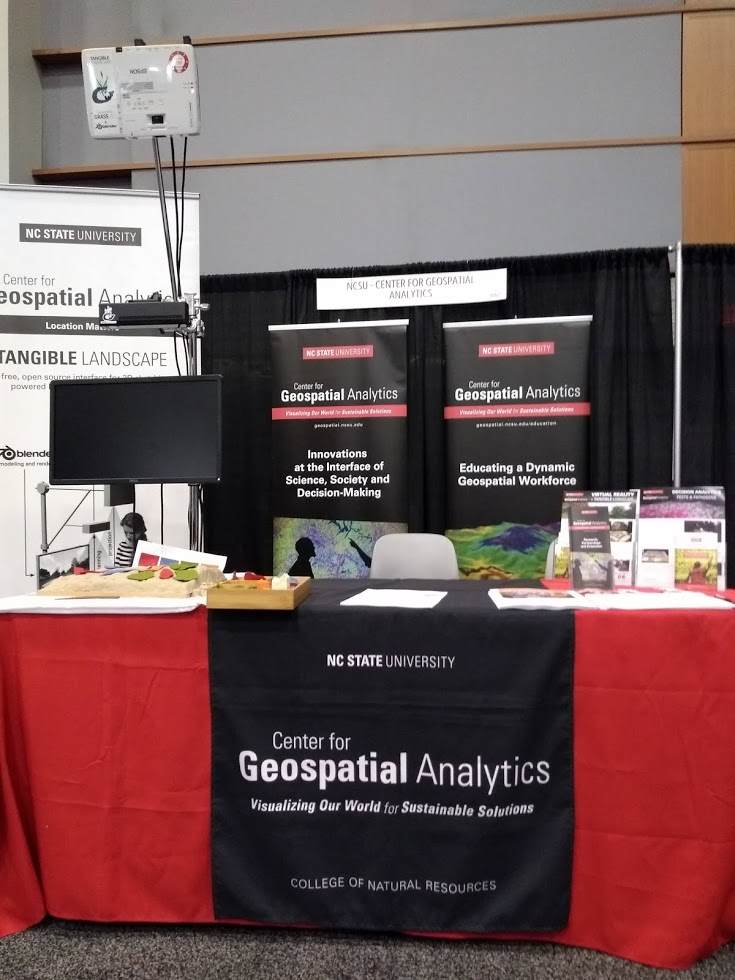
- North Carolina State University, Raleigh, North Carolina, United States of America
- NCSU Center for Geospatial Analytics was promoting NCSU, the center, and its educational programs, especially new PhD program in Geospatial Analytics.
- A live iterative Tangible Landscape demo was part of the booth.
- Besides NCSU CGA flyers and stickers, Tangible Landscape and GRASS GIS flyers and stickers were provided because of involvement of NCSU CGA in these projects.
- Tangible Landscape demos: surface water flow and ponding, planting trees, drainage and contributing area, routing and blocked streets, coastal flooding, HAND
- NCSU CGA students, postdocs, and faculty were present at the booth.